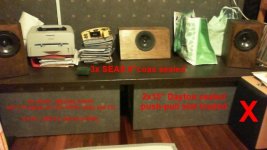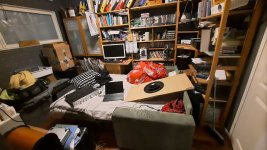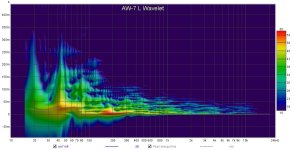with respect to Mayhem’s comment on time. The best you can do — without some sort of metamaterisl — is likely effective over about an octave.
You can get an idea by measuring the difference beteen shortest and longest reflection. Some diffraction effects from the angled bits help the higher frequencies.
We have used a techniquee broadly similar ocracked case’s illustration for hwlf-wave midTls. I first saw it in the eary 70s.
dave
You can get an idea by measuring the difference beteen shortest and longest reflection. Some diffraction effects from the angled bits help the higher frequencies.
We have used a techniquee broadly similar ocracked case’s illustration for hwlf-wave midTls. I first saw it in the eary 70s.
dave
Thank you guys for All the repleys!
I have decided just to go and try. I literally cooked some veneer in hot water so I can bend it easily (my wife being very patient as always 🙂 and created cones. I will stuff them to certain degree and place them all over the place. Especially behind the driver.
I have decided just to go and try. I literally cooked some veneer in hot water so I can bend it easily (my wife being very patient as always 🙂 and created cones. I will stuff them to certain degree and place them all over the place. Especially behind the driver.
This looks great, probably the most effective I've seenView attachment 1366444View attachment 1366445
To be honest, you're starting of with a cube, which is not the best starting point; I'd go for a double V diffuser (drawing), going from one side to the other, much like the single V diffuser (picture).
I did use a cube enclosure many years ago, and found different types of foam, in different layers worked well; however some experimentation was needed to find the best combination/order of foam. If memory serves my right, the first layer was a course open cell foam, followed with a finer foam against the rear wall. I may have used cotton wool as well.
The older model has about 10liters less. I can't share the crossover with respect to Troels Gravesen. But I have already built it once and have fond memories of itMk1 details are hidden.. Actually MkII xo is 2.0 type!
Is the box similar? It's almost 1000mm high - very low first mode! Troels uses lots of stuffing and covers walls with bitumen and felt. Perhaps some diffusers right behind woofers might attenuate mainly reflections directly from back- and sidewalls, around 1-3kHz.
Take nearfield measurements of woofers with diffusers! And as-is measurement for reference of course!
A preliminary search did not return any useful result on this topic so...
Is there any argument to be made in favour of utilising a an internal soundwave diffuser within an enclosure to break up standing waves or to any other benefit? Just to be clear, a diffuser role is understood not to absorb soundwaves, but merely change or sufficiently randomize their angle of reflection to break-up standing waves and resonant frequencies. In a studio or theatre environment, the panels can be quite large and cover a significant area. Lower frequency waves are longer than the longest dimension of most...
- lucadelcarlo
- Replies: 32
- Forum: Multi-Way
I'd make all the cones different heights, and fill their insides with something absorbent.
It could make sense if the next load was stuffed and sealed, but being open what you get is called an organ.
Way to attractive to hide inside a box!Weird looking stuff but worth a try
Which leads me to directly to the essence: why even bother inside the box - make some room diffusers instead!
I think if you market this properly you’ll sell a million of them.More Weird ideas!
Trying to combat the evil of rear cabinet reflection without the obvious solution-fiberglass or sheep wool.
Will it work? what do you think will happend?
View attachment 1366042
Yes, sadly it will work only if 4 of them will cost 400€. Audiophile thing, go figure 🙈think if you market this properly you’ll sell a million of them.
Not if I'll stack them and put some felt between. Gonna do thatThat's gonna resonate like a sonofab!tch
Done!Way to attractive to hide inside a box!
Which leads me to directly to the essence: why even bother inside the box - make some room diffusers instead!
Of course, you could always make your own midrange "meta" labyrinth, like the tweeters of some KEF tweeters. Perhaps collect some wooden drink stirrers from fast food restaurants, and glue them in place at the back of the enclosure, then add baffles over, then anouther layer. I've drawn two layers, but you could have a few more. Some people have 3d printers, they could print off a labyrinth sleeve that slides in.
Last edited:
Also thought just to stick a box with many many sticks from different angels and send them down , it will look like a magic box full of sunken swords or like a Swiss cheese 

Another idea is, you could have a few dividers, with lots of hole drilled through; enough holes to let soundwaves pass through, without significant reflections, but still cause a successive resistance - so the wave will emanate from the rear of the cone, pass through the first divider, losing some of its energy, pass through the next divider, losing more of it's energy, bounce of the rear of the enclosure, pass again through the second divider, losing still more of it's energy, then again through the first divider, if there is anything left. Unfortunately, this design might dampen the movement of the cone, although if the first divider is half way down the enclosure, it shouldn't be to bad.
you could always make your own midrange "meta" labyrinth
The basic math is in a Speaker Builder/ AudioXpress article. You could also stick your head (and lasermesaurr) inside a Hegemony 1.
dave
you could have a few dividers, with lots of hole drilled through; enough holes to let soundwaves pass through, without significant reflections, but still cause a successive resistance
That sounds like my Holey Braces. Add a bit of dampimng (lower density) over the holes toincrease resistance/damp down harmonics.
dave
That's pretty cool idea 💡Another idea is, you could have a few dividers, with lots of hole drilled through; enough holes to let soundwaves pass through, without significant reflections, but still cause a successive resistance - so the wave will emanate from the rear of the cone, pass through the first divider, losing some of its energy, pass through the next divider, losing more of it's energy, bounce of the rear of the enclosure, pass again through the second divider, losing still more of it's energy, then again through the first divider, if there is anything left. Unfortunately, this design might dampen the movement of the cone, although if the first divider is half way down the enclosure, it shouldn't be to bad.
- Home
- Loudspeakers
- Multi-Way
- Loudspeaker Chaos theory- inside diffuser





